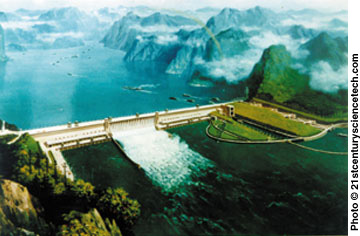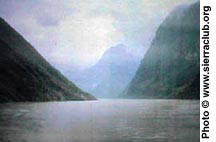
(This text was delivered by Dai Qing at the Cleveland Museum of Art, March 27, 2002 )
Few people realize that two main civilization systems developed in parallel in ancient China: the Yellow River civilization of the Han culture, and the Yangtze River civilization of the Ba and Chu cultures.
Chinese archeological work began in earnest in the 1920s. And until the 1970s, archeologists concentrated their attention on the Yellow River valley. Their neglect of the Ba/Chu civilization
Since the middle of the 1980s, when the central government revived an old plan to build the huge Three Gorges dam, many Chinese archeologists have been terribly worried about the region’s archeological treasures. Numerous historic sites and cultural relics are

Yu Weichao, the preeminent archeologist and former director of the Museum of Chinese History in Beijing, has summarized the value of the Three Gorges archeological treasures as follows:
More than 60 archeological sites and ruins containing fossils and other evidence of extinct life forms and of human activity dating back to the Old Stone Age have been identified in the Three Gorges area. Fourteen of these sites have remained completely untouched, including an open-air site discovered in the town of Gaojia in Fengdu county, where stone tools were produced in the Old Stone Age.
A large number of stone tools, such as choppers and scrapers characteristic of south China, have been found at these sites. These show that the Three Gorges area contains invaluable information pertaining to the two civilizations that developed in north and in south China. This important evidence could help determine the dividing line between those two Paleolithic cultures.
More than 80 archeological sites and ruins dating back to the New Stone Age have also been found. These could be the key to identifying the dividing line between the cultural systems that developed in east and in west China – specifically, the culture of the Jianghan Plain to the east, and the one to the west, in the Three Gorges area and beyond, in the Sichuan basin along the Yangtze River.
More than 100 historic sites and tombs belonging to the Ba people have been identified in the Three Gorges area. These Ba sites functioned as political, economic and cultural centres from as early as the Xia dynasty, which began in the 21st century BC, up to the Qin dynasty, which ended in 206 BC. Proper archeological investigation of this area would help us gain an understanding of the intriguing Ba culture, about which little is known.
Studying other archeological sites and tombs in the Three Gorges area would allow us to figure out how the Chu culture and the Qin culture developed and spread in the region. The influence of the Chu culture had reached Xiling Gorge, around the Zigui area, in the mid or late Western Zhou Dynasty, which began in the 11th century BC. The Qin people conquered the Chu in 278 BC, occupying the Chu capital, Yindu, near present-day Jingzhou in Hubei province, and ruling over the whole Three Gorges area.
The Zhongyuan culture, which formed part of the Yellow River civilization, was situated mostly in Henan province. To understand the Zhongyuan culture and how it interacted and gradually blended with that of the Ba people, archeologists need to properly excavate and study 470 sites and tombs, including the two ancient county seats of Yufu and Juren. The dates of all of these sites range from the Han dynasty, which began in 202 BC, to the Six Dynasties period, which ended in 589 AD.
Six sites contain ancient inscriptions carved in stone that record dry-season water levels, while 10 other sites record the flood-season water levels. These sites, containing precious hydraulic information about the Yangtze River, date from the Song dynasty, which began in the 10th century AD. One of the best known of these sites is Baiheliang (White Crane Ridge), which may be the world’s oldest hydraulic monitoring station.
Other things that will disappear include stone carvings made in the Eastern Han dynasty, which began in 25 BC; and dozens of Buddhas and stone tablets carved with poems and prose dating back to the culturally rich Tang dynasty of the 7th to 10th centuries. These are not only precious works of art; they also contain irreplaceable information about the region’s history.
Hundreds of magnificent structures dating from the Ming and Qing dynasties – from the 14th to the early 20th centuries – will be lost. These include temples, houses and bridges, set against beautiful natural landscapes and providing a wealth of information about China’s traditional cultures. A host of relics belonging to the Tujia and other ethnic minorities help trace 4,000 years of cultural history in the Three Gorges area.
Other losses include some of the world’s most important relics related to ancient transportation methods – the plank roads carved into the sides of the steep mountains beside the Yangtze, and the towpaths built along its banks.
The early rulers of modern China were military men, and their successors in the 1980s were engineers. It is little wonder that no matter which of these leaders was in power, no care or concern was shown for preserving China’s human heritage or its natural resources and environment. In the leaders’ minds, industrialization – and later the stock market – were far more important.
No sociologists, anthropologists or archeologists were invited to take part in the feasibility studies for the Three Gorges project. In the initial budget for the dam, one-third of the funds were earmarked for construction, one-third for electricity transmission systems and one-third for resettlement costs. Not a single penny was set aside to help salvage historical relics.
Since the project was given the go-ahead in 1992, many Chinese scholars, writers, artists and archeologists – including the discoverer of Peking Man – have appealed to the central government to devote funds to this salvage operation. Finally, under growing pressure at home and abroad, the Three Gorges project authorities decided to take about US$60 million out of the US$5-billion budget earmarked for resettlement and put it toward the cultural rescue operation. These funds represent just one per cent of the resettlement budget.
In these circumstances, about 30 Chinese universities and research institutes have had to raise their own funds to send archeological teams to the reservoir area. It is thanks to their work that we now have a rough idea of what’s there and what will be lost. I’m told that these archeological workers are often staying in shabby hotels costing little more than a dollar a day. And because of their desperate lack of funds, about all that these researchers can do is survey what will be lost, rather than actually excavate sites or undertake much in the way of salvage and preservation.
More importantly, government and project authorities have paid little attention to the salvage operation. It seems extremely difficult for them to take these sorts of things seriously. As a result, the situation has handed thieves and smugglers a golden opportunity to steal the treasures and sell them on the black market.
It came as a real shock when a priceless bronze “money tree” unearthed from the Three Gorges area and dating back 2,000 years to the Han dynasty was sold for US$4 million in New York in 1996. Premier Zhu Rongji, who is in charge of the Three Gorges Project Construction Committee, was outraged when he heard the news. After his personal intervention, an additional US$375 million was earmarked for the salvage work.
The Three Gorges reservoir is due to be filled in June next year. This socialist megaproject will uproot two million people, submerge 48,000 acres of good quality farmland, endanger some precious animal and plant species, and plunge many priceless historical relics permanently under water.
Under Mao Zedong, the central ideology in China was class struggle. Under Deng Xiaoping and Jiang Zeming, it became “to get rich is glorious.” It is not hard to foresee the fate of the archeological relics in the Three Gorges area. You need only compare the attention that is paid to the different parts of Beijing: China’s capital has magnificent new shopping centres – and poorly funded, dilapidated museums.
Text reprinted from www.ThreeGorgesProbe.org
Articles About Tibet
Music
Novels